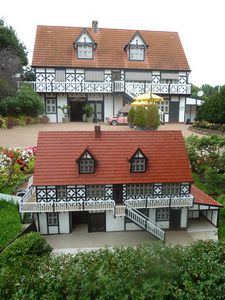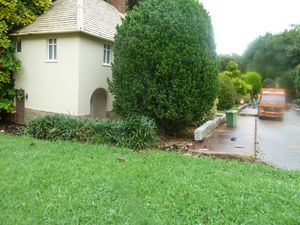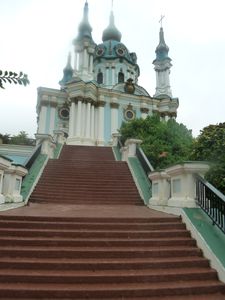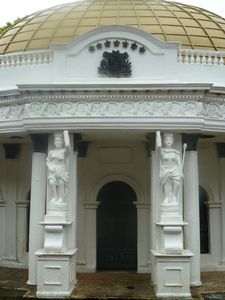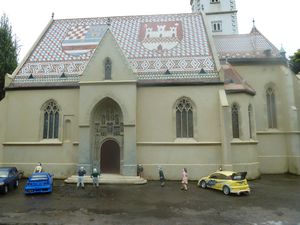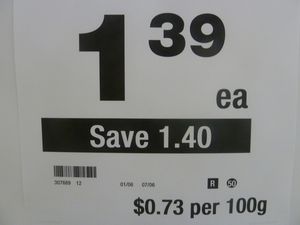When I arrived in Australia I had no doubt I will find a job easily. Indeed, Australia had the reputation to have a lot of positions available (the rate of unemployment is very low, about 5% in January).
Nevertheless, that was maybe true some years ago, but it's not really still the case now. There is a huge competition on the labor market and I'm not on the best place to apply.
Indeed, tuition-fees to study in Australia are very important. In addition, the number of lesson hours per week is low. Consequently, students often look for a job in order to finance their studies. If employers have the choice between them and me, they would choose them. The reason is that Australian are patriots, and so they help each other when they can. An Australian employer would prefer to hire an Australian student that a foreign one, also because he speaks a native Australian English and could be more efficient than the overseas student.
In addidtion to this, the population of Sydney include a huge proportion of people from Asia, notably from Corea. These people own the majority of the small businesses or are the managers. Moreover, Asian hire only other Asian. They are very interdependent and help each other at every time. When an Asian leave his position, he always have a friend to get the position instead of him. They also have their own recruitment website, only for them. Asian managers will recruit on these website, without making any hiring offer on regular recruitment website.
For instance, with a friend we saw a new KFC which was just opening. Consequently, the manager (from Asia) had to hire all the staff (i.e. a lot of people). We applied with some other people from Asia. One week after, without any news from the manager, we came back to follow up with him and we saw the employees... exactly the same people that had applied with us. We were the only two applicant from Europe and we were the only two applicant that the manager didn't hire... Asian restaurant or shops would like to hire Asian applicants to speak their native language and because it's normal, for example, to find an Asian staff in an Asian restaurant. On the contrary, in French bakery, you also find an Asian staff, maybe because the manager is Asian or because French don't have the same reasoning (French staff is better for a French bakery).
Last, I was in competition with other foreign applicants with a working holiday visa. They can work at any time without having any dependance on an university timetable and they can work more than 20 hours per week while I can look only for part-time or casual jobs. They also can move to get the location where the job is. I can't do the same because I must stay in the area of my university. Furthermore, they are more numerous in Sydney this year because of the disasters in Queensland and Victoria had reduced the number of positions available in farm, notably to work in "fruit picking".
On the other hand, most of the positions availables are cash-hand paid and I couldn't accept.
In these conditions, find a job in Sydney is a big challenge !
There are several way to find a job.
First, it's possible to check the recruitment website on internet (seek.com.au ; careerone.com.au ; mycareer.com.au ; gnjob.com.au ; gumtree.com.au ; seasonalwork.com.au ; jobsearch.gov.au). However, there are more people looking for a job than people looking for hiring somebody. The jobs I can do in Australia don't require any qualification. Consequently, to be hire you have to be lucky and be the first or almost to apply for the position, which is probably not the case. I have applied for many positions on internet and I never receive any answer, even negative, even when I had applied for an internship position without remuneration. Sometimes, the hiring offer is false and hide another job that the one which is described. For example, some people try to launder money by your intermediate. They could offer to pay you to make some international money transfer for them.
Second, there are some hiring offer on the job locations, on the electricity pole in the street and on newspapers such as the Sydney Morning Herald (Wednesday and Saturday). They could be a good way to find a job but you have to call the employer asap because it's often the first one who call who is hired.
Third, the word of mouth it's, in according to me, the best way to find something. You must explain to everybody you know you are looking for a job. Like this, you will learn that an acquaintance of a friend of you will leave its job or that the company for which your acquaintance is working for is hiring and that you can apply directly to the manager's email adress. I find all my jobs like this !
Last, you can join a placement agency which can link employers to job seekers. The problem is that you have to pay for that. The agencies often offer you to pay only after they find a job for you. However, some agencies only want to make money. They give you a job for a long time, but after some days your employer makes an end to your contract to hire another people from the agency. Otherwise, the jobs are casual, not regular.
During my research, I noticed that in Sydney it's often easier to a woman to find a job. Indeed, the hospitality industry (waiter jobs, bartenders, kitchen staff...) is a very attractive option for working. Some employers are only looking for hiring women (above all with nice looking) because they think it's better to lure customers. In "The Gaff", for example, if you would like to have a chance to be hired, you have to be a woman with a very nice looking. I also have the experience of an employer who refused to take my resume because I'm not a girl...
On the website "Gumtree" you can find some offer ending by "to be eligible to apply for this position you must have an appropriate Australian or New Zealand work visa" or "excellent communication skills both written and verbal are necessary". They are example of the barrier I could meet by looking for a job. My French accent was disabling to find a job. Other barriers are the certificate you must have to work in some industries. For example, to work in a bar, a pub, a restaurant or a nightclub you must have your "RSA" (Responsible Service of Alcohol) that is an evidence that you know how to deal with alcohol and consumers (for instance, you can't serve people under 18 years old or drunk people). This is a formality and everybody who try to have it success. In my case, the official paper was signed before my exam was corrected. In brief, you must pay to have the right to work. The RSA cost between $50 and $90. Often, employer refruse to take you resume if you don't have your RSA. A lot of people lie, telling they have it and pass it after having the confirmation to be hired when they must show the certificate... In the same idea, to serve coffee, you should have a certificate named "Barista" and to work in the construction industry (it will be soon the case of the labour industry too) you must have a "White Card" that cost around $90. It's possible to pass these certificate on an specialized agency or on internet. However, on internet you must be careful because some certificate are not reconized or are not valid in another state. So, if you have your RSA from a Queensland's website, you should check it would also be valid in New South Wales...
During one semestre I had given many resume everywhere, looking for every kind of job at every time (above all jobs in the hospitality industry). I applied online to Apple, MacDonald, Hungry Jack's, the Australian Post, the Westpac Bankling Corporation and a lot of other companies. I was very lucky when I had an automatic negative answer. In many case I never had news about my application... I paid to be in an agency which never tried to find a job for me. I had some interviews but only thanks to myself.
I find anyway some casual jobs. First, I heard about the agency "First choice placement" on a Thursday and I had an appointment at the office of Bondi Jonction on Friday morning. As soon as I was there, the boss gave me the papers to fill in (tax file number declaration, formal declarations and contract to sign). Just after I finished to fill in these files he gave me a map and a file about the job to do and told me I have to leave asap in order to join a supermarket in the area of Paramatta (NorthMead) quickly. I must read the file in the train to be ready to work as soon as will be arrived. The file explained I will realize the stocktake of all the supermarket product with other people and explained how to proceed to make a good job and to respect the rules. Then, I arrived to the supermarket and began to work without having time to have lunch. I work during 5 hours and a half in the supoermarket , counting the products leaving on the shelves. It wasn't a good job but I earned money in the same time I had a work experience in a foreign environment. I learnt how a supermarket deals with its stock and how it organizes its products into the shelves. I also saw how it's possible to hire and train very quickly a new staff for only one day of work.
Second, a friend find a casual job in the company "Show support" thanks to his agency on a Thursday. He gave me the details of the company and I called it in the case it needs more labour employee. It gave me a positive answer and I left Sydney on Saturday with the company's bus in order to join the EnergyAustralia Stadium of Newcastle (2 hours from Sydney). I had work there during 3 following shifts (24 hours) and I came back to Sydney on Sunday. This labour work had consisted in assembly and dissasembly all the equipment such as motorbike and bike jumps for the Nitro Circus (of Travis Pastrana) Australian tour. It was a big reponsibility because motorbiker had risked their lifes on these equipments.
Casual jobs have some disavantages. The jobs are always for a few hours and you have to wait to be contacted by the company to work. Sometimes, you know there is some work available but the company never give you any work. THis kind of company have often a huge number of employees and a big turnover. Nothing is regular, the work timetable always changes. I think this kind of companies that offer casual jobs use "disposable employees". Indeed, no qualification or experience are necessary to work and the number of people willing to work is important. If the wage is less than $450 for a month the employer mustn't pay money into a superannuation fund on the employee behalf. For this reason, I suppose companies prefer to stop do give work to an employee before to pay him more than $450 a month... Another problem of casual jobs is that you always must invest before to work. Indeed, you must buy the company uniform, required tools and others by your own way. Sometimes, the first time you work for a company only let you covering these costs. You have to be patient with casual job companies. I have also joined two others: "Crew on Call" and "ShowCall" but for the moment only one offered me to work one time. Unfortunately, I couldn't because it was in the same time I had an eximanation at the university.
I find several employer willing to hire me, but always with cash-hand paid. In Sydney, i's a common way to pay employee without qualification, above all in the hospitality industry.
I also find some good job, such as French teaching, but too late. As far as regular jobs (part-time) are concerned, employers often prefer you stay a long time, at least 6 months. The one of French teaching keeps a bond on the wage in case of his employee (the teacher) decides to stop to work for him before a minimum of some months. Consequently, shorter and shorter my leaving time in Sydney was, smaller and smaller was my chance to find a regular job.
To put it in a nutshell, to find a job in Sydney for a student is not so easy that I had thought. It's not impossible but it's often cash-hand paid or casual. Casual jobs are better than nothing. By doing them I could meet other people and keep contact with some of them. I had worked in hard working-conditions as a labourer and had seen how these kind of companies work and are organized (notably recruitment and training process). To work casually, patience is important and it's very difficult to realize a lot of hours in a few time. I had only done about 30 hours in all my semestre and it was during the same period (maybe the busiest one).





















 Dinausaure Museum (see picture bellow) in Belc
Dinausaure Museum (see picture bellow) in Belc